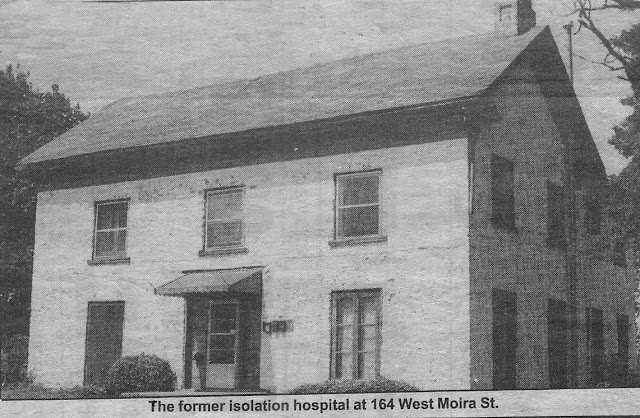The Fever House
The sight of red fluorescent signs on the doors and fences of homes in the city neighbourhoods struck fear and panic in the hearts of those yet to experience the battle being fought indoors. Anxious mothers kept their children closer to home, adults warily kept their distance and city authorities did what they could to keep the public enemy - scarlet fever, the scourge of the day, at bay.
Beginning in 1908, the city of
Belleville operated an isolation unit of the local hospital at 164 Moira St. W.
The building was former home of a person named Asa Yeomans. On the gate leading
to the house was a sign that read Scarlet Fever and in later years, the house
became popularly known as the Fever House. Area residents suffering from
contagious diseases were brought to the building to be kept in isolation for as
long as two weeks at a time. It was the only way the city health authorities
thought they could keep the infection from becoming an epidemic at the time.
A local resident, who requested to
remain anonymous, recalls being in the building as a small child in the late
1920s. At the time, he recalls, his family was living on Victoria Avenue and
was in the middle of moving to a new home on Bridge Street East.
"By putting me in the hospital the
rest of the family could move. Mother used to put a quarantine sign in the
windshield of the car and drive across town to visit me. In the hospital we
were segregated into rooms according to what we had scarlet fever in one room,
diphtheria in another etc. As I recall, one nurse was on duty at a time…Oddly
enough just after the move my father and younger brother both came down with
Scarlet Fever and the new house was quarantined and I had to stay at the
isolation unit as they wouldn't let me return home and be exposed again."
A lone nurse whose last name was Booth
took care of the patients while in quarantine. She was at the same time in
charge of administration, food preparations and serving meals to the patients.
Booth was often seen riding her bike on a grocery run to Twiddy’s corner store
that was located just down the street.
Late Dr. James Forrester, a well-known
physician in Belleville who first arrived in the city in the mid-30s, was known
to attend to the ailing at the isolation unit.
Named for the flushing of the face that
it causes, scarlet fever, characterized by a sore throat, chills, fever,
headache, vomiting, rapid pulse, red rash, and an inflamed brightly red tongue,
was much feared prior to the discovery of antibiotic drug. The disease was
called scarlet fever by Thomas Sydenham, an English physician in the 1650s.
Through detailed records he kept of the symptoms shown by his patients, he
began to understand the differences between measles and scarlet fever,
previously assumed to be the same disease. His thoughts were followed up by
early twentieth century pioneer in the field of respiratory diseases, Alphonse
Dochez, who studied many cases of scarlet fever as a doctor during World War I.
His study of the relationship between streptococcus bacteria and scarlet fever
at Columbia University led to the development of an antitoxin to treat scarlet
fever. In 1924, Anna Wessels Williams, an American doctor concluded that not
all scarlet fever toxins were identical, refuting the ability of antitoxins to
successfully treat the disease. This all changed during the 1930s and 1940s
when antibiotic drug was introduced to the world. Because streptococcus
bacteria is the cause of scarlet fever, antibiotics became a treatment of
choice to get rid of the disease that once caused grief and some embarrassment
to individuals who suffered from it. The new drug prevented the kind of
epidemics familiar to communities everywhere in the past.
The isolation unit on Moira Street was
sold in the 1940s and was converted into apartments soon after.




Comments
Post a Comment